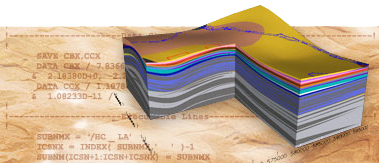
STOMP User Guide
Subsurface Transport Over Multiple Phases

STOMP User Guide
Subsurface Transport Over Multiple Phases
Introduction
Welcome to the User Guide for PNNL’s Subsurface Transport Over Multiple Phases Simulator (STOMP). This Guide will provide users with an easy way to understand and work with the STOMP simulator.
The STOMP simulator has been designed to solve a wide variety of non-linear, multiple-phase, flow and transport problems for variably saturated geologic media. Partial differential conservation equations for component mass, energy, and solute mass comprise the fundamental equations for the simulator. Coefficients within the fundamental equations are related to the primary variables through a set of constitutive relations. The conservation equations for component mass and energy are solved simultaneously, whereas the solute transport equations are solved sequentially after the coupled flow solution. The variable source code configuration allows the user to select the combination of solved fundamental equations. Operational modes are classified according to the solved governing flow and transport equations and constitutive relation extensions. The associated constitutive relations for each operational mode are automatically incorporated into the source code as required.
The current version of the STOMP simulator recognizes several coupled flow equation combinations. Each coupled flow equation combination includes the solution of a number of transported solutes. Reactive transport is implemented through the ECKEChem module. The Barrier module includes an evapotranspiration model implemented as a boundary condition in the upper surface of the computational domain.
In using the STOMP User Guide, it is important to distinguish between phases and components. Phases are composed of components. The terms aqueous, gas, hydrate, nonaqueous phase liquid (NAPL), and solid are used exclusively in referring to phases. The terms water, air, CH4, CO2, oil, and salt refer to components. The aqueous phase is primarily composed of liquid water with lesser amounts of dissolved oil, CH4, CO2, air, and salt. The gas-phase composition can be highly variable, and may contain air, water vapor, and oil vapor. The hydrate phase is composed of CH4, CO2, and water. The NAPL phase is assumed to be composed of liquid oil only with no dissolved air or water. Dissolved oil and transported solutes can sorb to the solid phase (i.e., the solid rock/soil matrix).